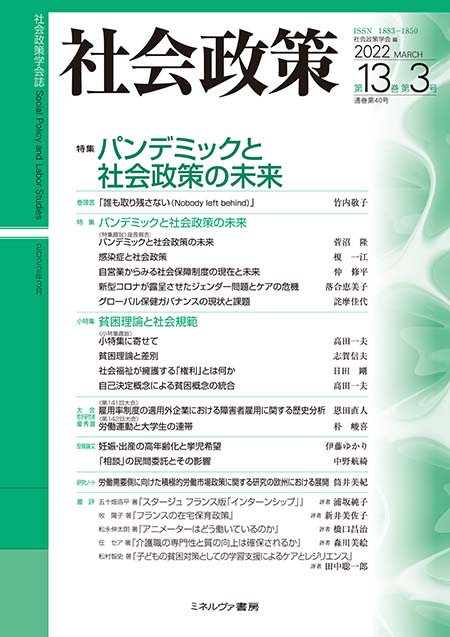Volume 13, Issue 3
Displaying 1-24 of 24 articles from this issue
- |<
- <
- 1
- >
- >|
Foreword
-
2022Volume 13Issue 3 Pages 1-3
Published: March 31, 2022
Released on J-STAGE: April 01, 2024
Download PDF (630K)
Special Issue :The Pandemic and the Future of Social Policy
-
2022Volume 13Issue 3 Pages 5-15
Published: March 31, 2022
Released on J-STAGE: April 01, 2024
Download PDF (805K) -
2022Volume 13Issue 3 Pages 16-27
Published: March 31, 2022
Released on J-STAGE: April 01, 2024
Download PDF (979K) -
2022Volume 13Issue 3 Pages 28-41
Published: March 31, 2022
Released on J-STAGE: April 01, 2024
Download PDF (1067K) -
2022Volume 13Issue 3 Pages 42-56
Published: March 31, 2022
Released on J-STAGE: April 01, 2024
Download PDF (1064K) -
2022Volume 13Issue 3 Pages 57-66
Published: March 31, 2022
Released on J-STAGE: April 01, 2024
Download PDF (823K)
Special Report : Poverty as a Social Norm:Toward a New Theory of Poverty
-
2022Volume 13Issue 3 Pages 67-68
Published: March 31, 2022
Released on J-STAGE: April 01, 2024
Download PDF (560K) -
2022Volume 13Issue 3 Pages 69-81
Published: March 31, 2022
Released on J-STAGE: April 01, 2024
Download PDF (845K) -
2022Volume 13Issue 3 Pages 82-93
Published: March 31, 2022
Released on J-STAGE: April 01, 2024
Download PDF (893K) -
2022Volume 13Issue 3 Pages 94-101
Published: March 31, 2022
Released on J-STAGE: April 01, 2024
Download PDF (792K)
JASPS Young Researcher Award for Best Conference Paper
-
2022Volume 13Issue 3 Pages 102-115
Published: March 31, 2022
Released on J-STAGE: April 01, 2024
Download PDF (940K) -
2022Volume 13Issue 3 Pages 116-127
Published: March 31, 2022
Released on J-STAGE: April 01, 2024
Download PDF (1088K)
Articles
-
2022Volume 13Issue 3 Pages 128-138
Published: March 31, 2022
Released on J-STAGE: April 01, 2024
Download PDF (791K) -
2022Volume 13Issue 3 Pages 139-149
Published: March 31, 2022
Released on J-STAGE: April 01, 2024
Download PDF (924K)
Research Note
-
2022Volume 13Issue 3 Pages 150-157
Published: March 31, 2022
Released on J-STAGE: April 01, 2024
Download PDF (769K)
Book Reviews
-
2022Volume 13Issue 3 Pages 158-161
Published: March 31, 2022
Released on J-STAGE: April 01, 2024
Download PDF (829K) -
2022Volume 13Issue 3 Pages 161-164
Published: March 31, 2022
Released on J-STAGE: April 01, 2024
Download PDF (826K) -
2022Volume 13Issue 3 Pages 164-167
Published: March 31, 2022
Released on J-STAGE: April 01, 2024
Download PDF (829K) -
2022Volume 13Issue 3 Pages 168-172
Published: March 31, 2022
Released on J-STAGE: April 01, 2024
Download PDF (830K) -
2022Volume 13Issue 3 Pages 172-175
Published: March 31, 2022
Released on J-STAGE: April 01, 2024
Download PDF (823K)
-
2022Volume 13Issue 3 Pages 176-181
Published: March 31, 2022
Released on J-STAGE: April 01, 2024
Download PDF (438K) -
2022Volume 13Issue 3 Pages 182-184
Published: March 31, 2022
Released on J-STAGE: April 01, 2024
Download PDF (599K) -
2022Volume 13Issue 3 Pages 186-187
Published: March 31, 2022
Released on J-STAGE: April 01, 2024
Download PDF (570K) -
2022Volume 13Issue 3 Pages Cover2-
Published: March 31, 2022
Released on J-STAGE: April 01, 2024
Download PDF (1098K)
- |<
- <
- 1
- >
- >|
